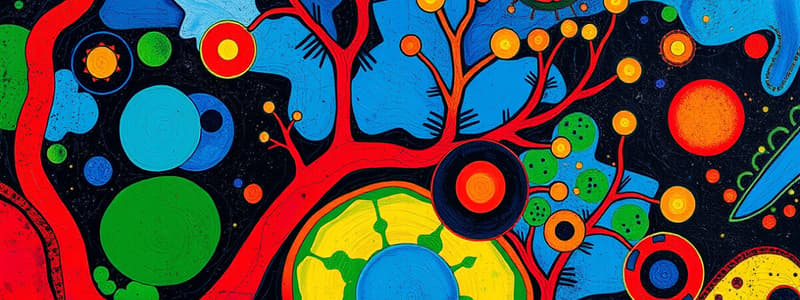Podcast
Questions and Answers
What are the seven characteristics of life?
What are the seven characteristics of life?
Cellular organization, response to stimuli, homeostasis, metabolism, growth and development, reproduction, and change through time.
What are the two types of cellular organization?
What are the two types of cellular organization?
Multicellular and Unicellular
List the units of organization within a multicellular organism from the smallest to the biggest.
List the units of organization within a multicellular organism from the smallest to the biggest.
Atom, Biological Molecules, Organelles, Cells, Tissues, and Organs
What is the basic unit around which an organism is organized?
What is the basic unit around which an organism is organized?
What is cellular organization?
What is cellular organization?
What is an organism composed of one cell called?
What is an organism composed of one cell called?
What does it mean to be multicellular?
What does it mean to be multicellular?
What is an atom?
What is an atom?
What is a biological molecule?
What is a biological molecule?
What is an organelle?
What is an organelle?
What are cells?
What are cells?
What are tissues?
What are tissues?
What are organs?
What are organs?
What is a stimulus?
What is a stimulus?
What is homeostasis?
What is homeostasis?
What are some internal conditions homeostasis seeks to maintain?
What are some internal conditions homeostasis seeks to maintain?
What is metabolism?
What is metabolism?
What is photosynthesis?
What is photosynthesis?
What are organisms who use the process of photosynthesis called?
What are organisms who use the process of photosynthesis called?
What are heterotrophs?
What are heterotrophs?
How do living things grow and increase in size?
How do living things grow and increase in size?
What is cell division?
What is cell division?
How does a unicellular organism grow and develop?
How does a unicellular organism grow and develop?
How does a multicellular organism grow and develop?
How does a multicellular organism grow and develop?
What is development?
What is development?
Why is cell differentiation/specialization important?
Why is cell differentiation/specialization important?
What happens as a result of development?
What happens as a result of development?
Of how many cells is the human body composed?
Of how many cells is the human body composed?
What is reproduction?
What is reproduction?
For what is reproduction essential?
For what is reproduction essential?
Why is hereditary information important to reproduction?
Why is hereditary information important to reproduction?
What is DNA? For what does it stand?
What is DNA? For what does it stand?
How is DNA partitioned?
How is DNA partitioned?
What is a short segment of DNA that codes for a single trait called?
What is a short segment of DNA that codes for a single trait called?
What are the two types of reproduction?
What are the two types of reproduction?
Flashcards are hidden until you start studying
Study Notes
Seven Characteristics of Life
- Cellular organization includes multicellular and unicellular organisms.
- Key characteristics are response to stimuli, homeostasis, metabolism, growth and development, reproduction, and change through time.
Cellular Organization
- The cell is the basic unit of organization in living organisms.
- Multicellular organisms are composed of many cells, while unicellular organisms consist of a single cell.
Levels of Biological Organization
- Organizational levels are: Atom, Biological Molecules, Organelles, Cells, Tissues, and Organs.
- Tissues are groups of similar cells working together, while organs are structures performing specialized functions.
Homeostasis
- Homeostasis involves maintaining stable internal conditions like temperature, pH, and nutrient levels.
- It responds to stimuli, which are changes in the organism's internal or external environment.
Metabolism
- Metabolism denotes all chemical reactions that convert energy and materials from the environment for use by the organism.
- Photosynthesis is a key metabolic process in plants to convert solar energy into food (sugar).
Nutrition Types
- Autotrophs create their own food via photosynthesis, while heterotrophs obtain energy by consuming other organisms.
- Growth occurs through cell division and enlargement, impacting both unicellular and multicellular organisms.
Reproduction
- Reproduction is crucial for species survival, allowing organisms to produce new, similar organisms through sexual or asexual means.
- Hereditary information is encoded in DNA, passed from parents to offspring, ensuring genetic continuity.
Development
- Development involves maturation into adult forms, requiring cell differentiation or specialization for proper function.
- Human beings originate from a single fertilized egg and develop into trillions of specialized cells through growth and division.
Genetic Information
- DNA (Deoxyribonucleic acid) holds the genetic blueprint for inheritance, organized into segments known as genes.
- Each gene codes for specific traits, contributing to the diversity and characteristics of living organisms.
Studying That Suits You
Use AI to generate personalized quizzes and flashcards to suit your learning preferences.




